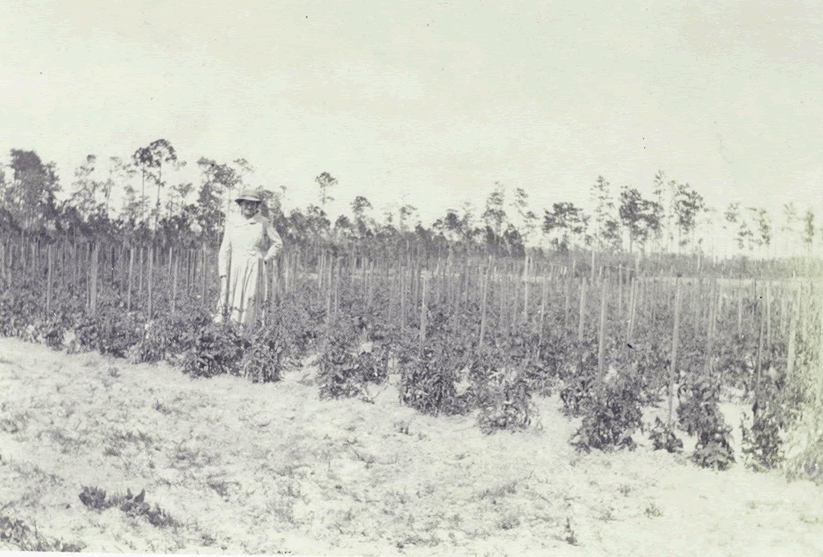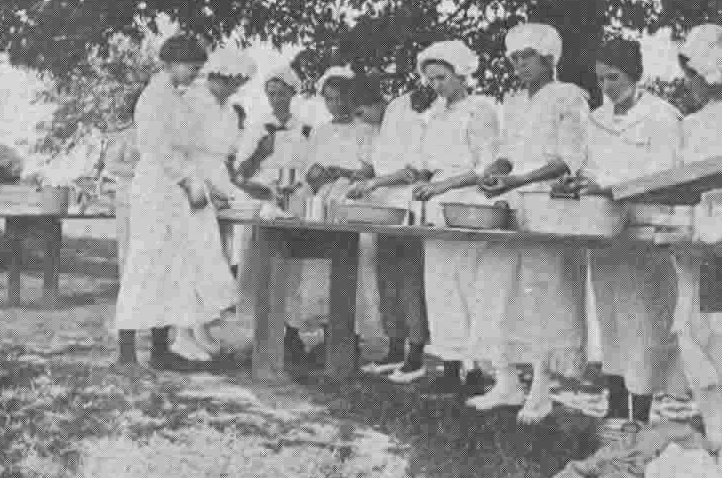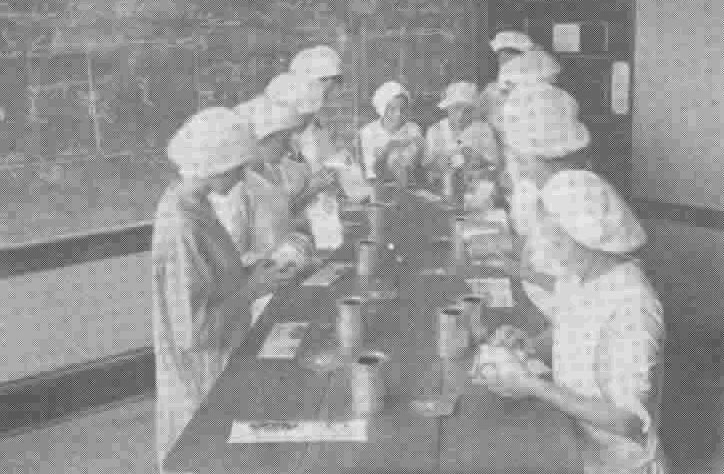In August 1939, seventy-seven-year-old Susie V. Powell reminisced about rural life in the early 1900s. In 1910 Mississippi was overwhelmingly rural, she noted, with the majority of Mississippians living on the land or in small towns dependent upon agriculture. She explained that the care of the farm family, plus maintaining the house and garden, was generally the domain of the homemaker, who completed chores in a difficult work environment: few farms had running water, much less electricity, to ease the endless drudgery of housework. Nevertheless, Powell, former state agent in charge of home demonstration work of the Mississippi Agricultural Extension Service, asserted the “heart” of the farm was the woman.
Despite Powell’s assertion, standard historical accounts provide little information on the roles of rural women in the early 20th century. However, the records of the girls’ tomato club movement, which preceded home demonstration work, are a rich source of information for developing the link in the history of rural Mississippi.
The girls’ tomato club movement was an educational project developed by rural reformers to improve the quality of life on the farm for women and their families. The underlying objectives of the formation of tomato clubs were two-fold. First, the clubs were organized to promote new home practices that could be carried out in a more convenient and efficient fashion by rural girls to make them more self-confident and more responsible for community problems when they became adult women. The second goal of the tomato club movement was to reach the kitchens of farm wives. Progressives [generally people who believe in the possibility and desirability of progress to improve the human condition] acknowledged from the beginning that girls’ club work would open homes of adult women to home economists. More efficient homemaking, they reasoned, would bring lasting changes in the nature of rural home production and improve the physical and psychological health of the entire farm family.
The beginning of girls’ tomato clubs is traced to Seaman A. Knapp’s farm demonstration work, which he pioneered in 1903 in Terrell, Texas. In December 1909, Knapp initiated plans for girls’ work when he sent Oscar B. Martin, head of the recently formed boys’ club division of Farm Demonstration Work, to speak on the topic before the State Teachers’ Association of South Carolina. Martin advanced the specific proposal that girls be organized into girls’ tomato clubs. He chose tomatoes because they could be grown easily, had a long growing season, and could be processed in rural kitchens. In addition, they were an important source of vitamins A and C, potassium, and niacin, all of which were lacking in the rural diet. Clubs could be open to any girl who had access to a one-tenth acre plot of land on which to grow a crop.
Susie Powell
Club work began in Mississippi in early 1911 when Knapp invited Susie V. Powell, then school improvement supervisor of the Mississippi State Department of Education, to attend a conference in Washington about girls’ tomato clubs. In this meeting, Knapp outlined his proposal to organize tomato clubs in rural communities in Mississippi and announced his decision to appoint Powell to head that effort. “Through the tomato plant you will get into the home garden and by means of the canning you will get into the farm kitchen,” Knapp informed Powell.
Knapp could have chosen no better person. With her immensely practical and sensible leadership, Powell, a tall, strikingly handsome woman, was the type of person needed to lead the movement in Mississippi. Born in Batesville and educated at Whitworth College in Brookhaven, the University of Mississippi, and the University of Chicago, she had already done much to improve teaching methods, facilities, and grounds of Mississippi rural schools.
Powell realized that if club work were to develop in a sound manner, it would need an effective organization with roots in the community where it was to function as well as the understanding, appreciation, and support of this movement by merchants and citizens, particularly the Mississippi Federation of Women’s Clubs.
A&M College
Powell also actively sought aid from A&M College [now Mississippi State University], which invited 370 club girls to an Institute Round-Up in 1912. Sessions included lectures on canning, proper food supply, and sanitation. In 1913, an A&M College professor gave a talk on textiles and, more importantly, established short courses where girls could take canning and cooking classes over a three-day period. These short courses became popular among farm girls, who welcomed the social interaction as a break from their isolation on the farm.
The method of establishing the first tomato clubs was dependent upon two factors: the agricultural conditions within a county and the willingness of individuals within its border to support the movement. Thus, Lincoln and Copiah counties formed the first clubs in the spring of 1911. Powell chose these counties because the educational forces there were well organized and the soil and climate were suited to growing tomatoes. Copiah County was also the tomato-growing center of the state.
The first girls’ club agents Powell employed were Mattie Furr of Lincoln County and Mabel McIntosh of Copiah County. They were rural teachers already familiar with the problems of farm life. They received $75 for two months of summer work. Inspired by Powell, the agents launched their drive. Traveling by horse and buggy on deep-rutted or muddy roads, their first objective was to locate and enlist girls who, with the consent of their parents, would agree to cultivate one-tenth of an acre of tomatoes according to specified rules. Then plots had to be measured, seed selected, and instructions given on how to cultivate, stake, and harvest the fruit. Next the tomatoes had to be harvested and the girls taught about food preservation.
First canning demonstration
Powell held the first canning demonstration in July 1911 at Whitworth College in Brookhaven. In the fall of that year, 152 tomato girls, wearing green-and-white uniforms, exhibited their canned products at the county and state fairs, along with record books of their work, and competed for prizes. Contests created excitement, and competition inspired girls to uphold their motto, “To Make the Best Better.” The 1912 state champion, Sallie Mae Strahan of Lincoln County, won a trip to Washington where she joined girls from sixteen other states. In 1914, one club girl, lacking proper canning containers, exhibited products in ink bottles and Vaseline jars at the state fair. She won first place and received five dollars from a Jackson physician. She spent the money on standard jars and won first place again at the 1915 state fair. One girl crossed a bayou on a skiff and walked several miles with her canned tomatoes in a basket to enter a contest. She won a pink parasol from a town merchant.
Canning also provided club girls with an opportunity to engage in commercial enterprises on a limited basis and in the process gain a measure of self-esteem through shrewd trading skills. Establishing markets for their produce was no easy task. Agents held training workshops in grading, display, and sale of produce. With this new knowledge, club girls began to promote and manage their own markets. Each member sold her own produce and collected her own money. Gradually, club girls established high standards for their products. Club members learned the value of participation in the outside economy and used the profits made from sales to further their education. One tomato girl, for example, used her prize money to attend a teacher’s college.
Meanwhile the girls’ club work moved into twelve additional counties during 1912. Ideally, reformers envisioned club work for all rural girls, and the programs were geared to improve rural life in general, but traditional socioeconomic and racial barriers hindered the growth of club work among Black girls and poor White daughters of tenant farmers and sharecroppers. Although Powell never placed restrictions on club membership and agents attempted to interest poor White girls, it is evident from agents’ reports that early efforts aimed at attracting mostly daughters of White middle-class families.
Club work for African American girls did not begin until 1917, when the wartime emergency of World War I made it necessary to include rural Black women in the food conservation program and federal legislation authorized the creation of programs for African Americans with appropriations to fund them.
4-H clubs
The [agricultural education] movement continued to grow as rural people increasingly began to see its value to family life. in 1913, the girls’ club movement came under the heading of the 4-H movement. Under the new system, girls’ 4-H membership increased to 4,000 in thirty-four counties in 1914, with the supervision of thirty-three agents.
The most successful clubs were those that maintained the interest of the mothers. Indeed, the expansion of tomato club work opened the doors of homes to agents and home demonstrations. By winning over the mothers of club girls, the agents achieved one of the rural reformers’ primary goals: educating rural women. The mothers began to request demonstrations and clubs of their own. In 1914, the federal government responded to their demands with the passage of the Smith-Lever Act. This act organized all of Knapp’s demonstration work under the Federal Extension Service and expanded it to include women’s home demonstration work. Powell established the first home demonstration club in Winston County in 1915. By the late 1920s, nearly twenty-four percent of all home demonstration agents in Mississippi had been members of tomato clubs between 1911 and 1915.
The reminiscences of Powell, whatever their limitations, do provide glimpse of the rich rewards the tomato club movement brought to rural girls and do confirm that the fostering of leadership among rural girls was a major contribution of early club work. In 1939, Powell noted that teaching the pioneer tomato girls “To Make the Best Better” led them to careers in teaching, both at the high school and college levels; in business, as proprietors of tearooms and other commercial ventures; in library work; and in journalism.
“Best of all,” Powell concluded, “the majority of the pioneer club girls became happy efficient homemakers and community leaders.”
Danny Moore, Ph.D., is chair and associate professor of history, Chowan College, Murfreesboro, North Carolina.
This article is condensed from Moore’s “To Make the Best Better”: The Establishment of Girls’ Tomato Clubs in Mississippi, 1911-1915, which originally appeared in the Summer 2001 edition of The Journal of Mississippi History, Volume LXIII, No. 2.
Lesson Plan
-

Susie V. Powell, first state home demonstration agent in Mississippi. Photo circa 1912. Courtesy May Quarles Collection, Extension Service History, Special Collections Department, Mitchell Memorial Library, Mississippi State University -

A club girl and her one-tenth acre plot of tomatoes, 1913. Photo from “Down South on the Beautiful Gulf Coast,” Volume 30, #4. Courtesy May Quarles Collection, Extension Service History, Special Collections Department, Mitchell Memorial Library, Mississippi State University
-

Club girls receive a demonstration on preparation for the canning of vegetables. Courtesy May Quarles Collection, Extension Service History, Special Collections Department, Mitchell Memorial Library, Mississippi State University -

Club girls compete in a can-labeling contest. Courtesy May Quarles Collection, Extension Service History, Special Collections Department, Mitchell Memorial Library, Mississippi State University
Suggested Reading
Danbom, David B. Born in the Country: A History of Rural America. Baltimore: Johns Hopkins University Press, 1995.
Flynt, J. Wayne. Dixie’s Forgotten People: The South’s Rural Whites. Bloomington: Indiana University Press, 1979.
Moseley, Lee H. "History of Mississippi Cooperative Extension Service." Mississippi Cooperative Extension Service Collection, University Archives, Mitchell Memorial Library, Mississippi State University.
Powell, Susie V. “Pioneer Club Work,” and “Resume of Tomato Club Work,” James E. Tanner Papers, University Archives, Mitchell Memorial Library, Mississippi State University, 1.
Scott, Roy V. The Reluctant Farmer: The Rise of Agricultural Extension to 1914. Urbana: University of Illinois Press, 1970.
Wessel, Thomas, and Marilyn Wessel. 4-H: An American Idea, 1900-1980. Chevy Chase, MD: National 4-H Council, 1982.
